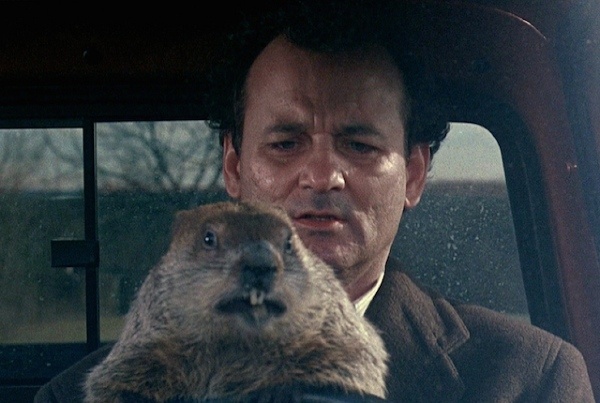Three little topics, each linked by Groundhog Day.
First, consider the traditional ritual of Groundhog Day: a moment in the midst of winter when we rely on a little furry creature to predict whether spring will arrive early or late. The comic shop segment of our industry is certainly in a winter season, a bit of a prolonged one already. Only we don’t have a furry friend to rely on; the funny animal segment of our field has been pretty dormant in recent years, and if memory serves, we’ve never had a really great groundhog comic. So we have to poke our heads out the door ourselves, and make our own guess about the future.
The shops have always been an optimist’s racket. How many times did each store owner hear, "You want to open WHAT?" Or, "When are you going to get a real job?" Small retail businesses of all kinds are a tough grind in modern America, and selling culture in any form isn’t easy. Not a lot of record stores around, the video rental business has dried up, and after being battered by the explosion of super-stores, the indie bookstores are fewer than there used to be. It took courage to open comic shops, as well as a deep love for comics and the people who enjoyed them.
I’m not sure what you’ll see if you poke your head out of your burrow, and serve as your own groundhog, but time it right, look in the right direction, and maybe you won’t see your own shadow, and you can believe spring is coming. Believing it is a big part of making it happen. There are reasons to believe.
Second, consider the movie Groundhog Day. Looked at one way, we’re having a bit of a Bill Murray moment. Comic shops have had a number of down years in the five decades this business model’s been around. A downturn in industry sales through this channel is bad news, of course, but it feels like the diagnosis of a nasty cold compared to, say, the massive heart attack of 1995. Comic shops are affected by many forces beyond their own control: the behavior of the major publishers they rely on to lure their customers in regularly is only one, and the general trends that have been hurting brick and mortar retail are another. But if you think back to the number of times either Marvel or DC failed to produce a strong line for a year or two before coming back to vitality, you’ll realize this is very much a repeating phenomenon.
Talent ebbs and flows between publishers, and has more hospitable places to work than ever before. Some of our great creators drift out of comics entirely, to try other fields, but other interesting folks are dipping their pens into our pages. A Brian K. Vaughan goes off to TV-land, then returns because comics are more fun. And a Marjorie Liu turns away from prose to enjoy visual storytelling. We’re winning that battle for talent more than on any previous Groundhog Day.
And third, for a moment, come back to Groundhog Day 1976. That’s when Jenette Kahn showed up at the DC offices: an outsider, young, and…gasp…female. She was as unlikely a publisher as comics had ever contemplated. The comics industry at that moment would have been thrilled to only suffer a 10% drop in sales: 1975 was a horrible year for the field, with publishers suffering or closing (Atlas, a promising experiment, disappeared) and talent getting clobbered by page count cuts and the miserable deals that were prevalent. I don’t mean to credit Jenette as the sole force turning the comics around; Jim Galton arrived as Marvel’s President just before. But new people in positions of authority, and new investments, can be good signs.
As we celebrate this Groundhog Day, we’re seeing new blood take the publishing helm at Marvel at a time when most retailers believe that’s a necessary and positive step, and we’ve seen significant investments in several mid-size publishers (some announced, some quieter). There’s good reason to believe that much of that investment will go into new projects and new ways to support the field.
And stepping aside from the Groundhog Day metaphor, bear in mind that this is the first ever (and by ever, I mean since the birth of the print comic book over 80 years ago) that we’ve had a downturn in sales of comics simultaneously with more people in America reading comics material than ever before. Sales for the shops may be down, but the potential customer base is larger than ever and growing at a significant pace.
This is critical. It means the opportunity for comic shop owners is brighter than it’s ever been. It’s not easy to attract these new customers to the shops. You’re competing with online retail, digital downloads, and most of them may not even know you exist. But it’s potential that we haven’t had since the declining days of the newsstand. Comic shops are a unique and culturally appropriate environment: we’re in an era of graphic communication, identification with creative properties, and young people who value experiences over products. Good comic shops can take advantage of all three of those factors.
Okay, gotta go poke my head out of my hole and see if my shadow’s there. I’m betting it isn’t. Spring’s around the corner.
The opinions expressed in this column are solely those of the writer, and do not necessarily reflect the views of the editorial staff of ICv2.com.

Column by Paul Levitz
Posted by Paul Levitz on February 2, 2018 @ 4:21 am CT
MORE COMICS
Starter Kit for Rebooted Universe
August 6, 2025
The box set is designed to be an entry point to the rebooted Ultimate Universe.
Whether It Wants to Accept Diamond's Consignment Agreements
August 6, 2025
The Ad Hoc Committee has filed a motion asking the court to force Sparkle Pop to decide whether it wants to assume the Diamond consignment agreements.
MORE COLUMNS
Column by Rob Salkowitz
August 5, 2025
In this week's column by Rob Salkowitz, he looks at the industry's biggest show, held in the midst of some existential issues.
Column by Paul Levitz
August 5, 2025
In this column, writer and former DC Comics Publisher Paul Levitz looks at the induction of Phil Seuling into the Will Eisner Hall of Fame.









